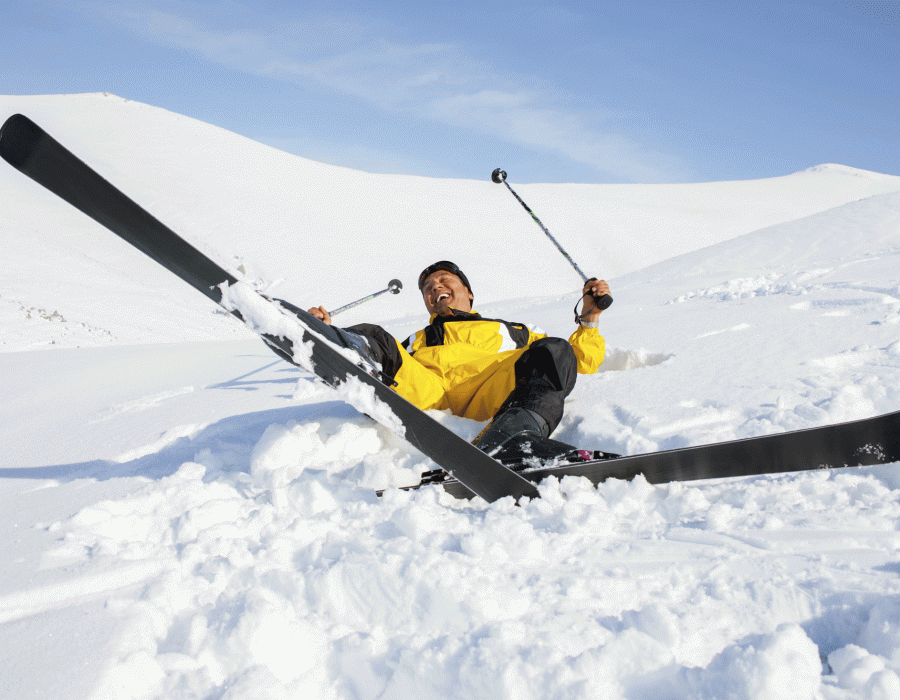Fitness and Performance
Avoiding Winter Sport Injuries

Introduction
We see an increasing number of injuries around the winter months that are commonly associated with winter sports. This is due partly to plummeting temperatures and also to the pressures that are placed upon the body during skiing and snowboarding. In this article our Sport Therapist Kiri Norton looks into the most common winter sport injuries and simple tips on how to avoid these injuries from occurring.
Common winter sports injuries include:
Twisted Knees
Medial collateral ligament and anterior cruciate ligament sprains or ruptures within the knee joint are exceptionally common, accounting for about 60% of all skiing injuries. These sprains occur when the knee is twisted under pressure while falling as there are large forces placed through the inside of the knee joint during skiing motion.
Skiers Thumb
This common problem relates to a sprain or rupture of the ulnar collateral ligament of the thumb and accounts for up to 20% of all skiing injures. Injuries to the ulnar collateral ligament occur when the skier falls on an outstretched thumb, with the injury risk increased when gripping an object such as a ski pole.
Fractures and dislocations of the upper extremities
These injuries are possible although far less common than twisted knees and skiers thumb. Falling upon an outstretched arm and hand can lead to fractures of the scaphoid, radius, ulnar, humerus & clavicle, dislocations of the shoulder and less commonly the elbow.
Head injuries
Direct trauma to the head is certainly a risk during ski season, whether from a collision with a fellow skier, a fixed object or a ski lift. Head injuries are vastly reduced by wearing helmets, but there is always still a danger that an extremely high impact incident could cause head trauma so vigilance is key. Be sensible and cautious, sticking to runs that are within your capabilities and taking all available precautions throughout your trip.
How can you avoid these injuries?
Learn from the best
Firstly, if you are a first-time skier, take skiing lessons! We cannot stress the importance of this enough. Even if you are holidaying with experienced skiers, there is absolutely no substitute for a trained instructor who can teach you skiing or snowboarding to a high standard.
Never participate alone
Always stay with a buddy or in groups when taking part in sports like skiing and snowboarding. This way, you will avoid getting lost and you will always have someone there to help you if you get injured.
Corrections to your technique
Small errors in technique can be missed by ‘amateur’ instructors, which could leave you suffering an unwanted injury.
Invest in equipment
Next you have to make sure you have all the correct skiing equipment before setting off. Get your ski boots professionally fitted and always wear your helmet. Head injuries are the most common admittance in alpine hospitals during ski seasons and the risk of a catastrophic head injury is reduced by 60% in skiers / snowboarders when a helmet is worn (Sulheim et al, 2006).
Mind the apres-ski!
Whether you’re enjoying a gourmet meal prepared by your chalet staff or hitting resort bars until the early hours, chances are there will be some form of alcohol flowing in various quantities and the effects on your next day on the slopes can stretch beyond a hangover from hell. The lasting effects of alcohol affect processes such as reaction time, balance and perceived risk which all factor into the risk of an injury occurring. There has been some evidence to suggest that approximately 50% of skiers and snowboarders who have fallen and suffered an injury, have consumed alcohol or drugs while on their ski season.
Layer up!
Layering up allows you to accommodate to your bodys constantly changing temperature. If you get too hot, you can always take a layer off. We recommend you wear several layers of loose, light and water resistant clothing, gloves to keep those hands warm, proper footwear which provides support, warmth and dryness and a couple of snoods to keep your neck warm. Snoods can also come in handy when the wind picks up, you can put it over your mouth and nose to prevent cold sores and frost bite.
Check your bindings!
Ensure your bindings are adjusted correctly to your height and weight. This will prevent injury and also enhance your technique on the slopes.
Warm up!
• Start your warm up with a brisk walk, this will increase your body’s temperature.
• Follow this with some arm swings and leg swings to increase the lubrication within your joints
• To get your spine moving complete some torso twists and thread the needle exercises.
• Stretch off those muscles to increase their elasticity. Some good stretches are hip flexor, adductor and hamstring stretches followed by some dynamic lunges.
Get a massage
Having a massage before you hit the slopes can help prepare your muscles for the day ahead by making them more pliable and supple. You can also have a massage after your long day on the slopes, this will promote tissue healing, aid the removal of waste products and reduce the risk of the muscles seizing and tightening up.